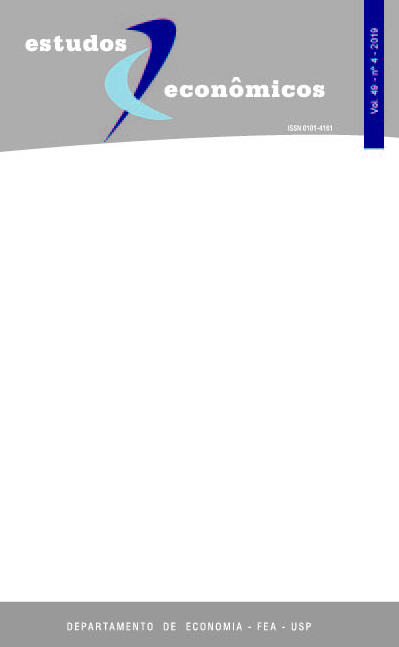Investor behavior in the Brazilian stock market
DOI:
https://doi.org/10.1590/0101-41614944jcssKeywords:
Market anomalies, Investor behavior, Investment decisions, Momentum, Disposition EffectAbstract
This paper investigates the behavior of groups of investors regarding their asset trading activities
in the Brazilian stock market. It analyzes how the buying and selling volume is related to past
and future market returns. The results stand out for individual and foreign investors. Individual
investors seem to be affected by the Disposition Effect - as they increase their sales after large
positive market returns, but do not do so after large negative market returns. Foreign investors,
on the other hand, are the only group that demonstrates positive and significant correlation
with past as well as future market returns. This result indicates that foreign investors are guided by Momentum strategies and have greater ability to process information, considering that their
portfolios show a better performance.
Downloads
References
Abinzano, I.; Muga, L.; Santamaria, R. 2010. The role of over-reaction and the disposition effect in explaining momentum in Latin American emerging markets. Investigación Económica, p. 151–186.
Badrinath, S. G.; Wahal, S. 2002. Momentum Trading by Institutions. Journal of Finance 57(6): 2449–2478.
Bondt, W. F. M. De; Thaler, R. 1985. Does the Stock Market Overreact? The Journal of Finance 40(3): 793–805, jul.
Chan, K. C. 1988. On the Contrarian Investment Strategy. The Journal of Business 61(2): 147, jan.
Costa Jr., N. et al. 2008. Disposition effect and gender. Applied Economics Letters 15(6): 411–416.
Costa Jr, N.; Goulart, M.; Cupertino, C.; Macedo, J.; et al. 2013. The disposition effect and investor experience. Journal of Banking and Finance 37(5): 1669–1675.
Costa Jr, N.; Goulart, M.; Cupertino, C.; Macedo Jr., J.; et al. 2013. The disposition effect and investor experience. Journal of Banking & Finance 37(5): 1669–1675.
Coval, J. D.; Shumway, T. 2005. Do behavioral biases affect prices? Journal of Finance 60(1): 1–34.
Cutler, D. M.; Poterba, J. M.; Summers, L. H. 1991. Speculative Dynamics. The Review of Economic Studies 58(3): 529, maio.
Edelen, R. M.; Marcus, A. J.; Tehranian, H. 2010. Relative sentiment and stock returns. Financial Analysts Journal 66(4): 20–32.
Fama, E. F.; French, K. R. 1988. Permanent and Temporary Components of Stock Prices. Journal of Political Economy 96(2): 246–273, abr.
Froot, K. A.; O’connell, P. G. J.; Seasholes, M. S. 2001. The portfolio flows of international investors. Journal of Financial Economics 59(2): 151–193.
Griffin, J. M.; Harris, J. H.; Topaloglu, S. 2003. The dynamics of institutional and individual trading. Journal of Finance 58(6): 2285–2320.
Grinblatt, M.; Keloharju, M. 2000. The investment behavior and performance of various investor types : a study of Finland ’s unique data set. Journal of Financial Economics 55(1): 43–67.
Grinblatt, M.; Titman, S.; Wermers, R. 1995. Momentum investment strategies, portfolio performance, and herding: A study of mutual fund behavior. The American Economic Review, 1088–1105.
Guercio, D. Del; Tkac, P. A. 2002. The determinants of the flow of funds of managed portfolios: Mutual funds vs. pension funds. Journal of Financial and Quantitative Analysis 37(04): 523–557.
Jegadeesh, N.; Titman, S. 1993. Returns to Buying Winners and Selling Losers: Implications for Stock Market Efficiency. Journal of Finance 48(1): 65.
Kahneman, D.; Tversky, A. 1979. Prospect theory: An analysis of decision under risk. Econometrica: Journal of the Econometric Society, p. 263–291.
Kamesaka, A.; Nofsinger, J. R.; Kawakita, H. 2003. Investment patterns and performance of investor groups in Japan. Pacific Basin Finance Journal 11(1): 1–22.
Karsten, J. G. 2005. O efeito de disposição: um estudo empírico no Brasil. [s.l.] Dissertação Escola de Economia de São Paulo Getúlio Vargas.
Lakonishok, J.; Shleifer, A; Vishny, R. 1992. The Structure and Performance of the Money Management Industry. Brookings Papers on Economic Activity 1992, n. 1992, p. Brookings Pap. Econ. Act.
Lakonishok, J.; Shleifer, A.; Vishny, R. 1992. The Impact of Institutional Trading on Stock Prices. Journal of Financial Economics 32(1).
Lee, J.-S.; Shen, C.-H.; Yen, P.-H. 2010. The study of the fund investors’ disposition effect vis-à-vis herding redemption and non-herding redemption: evidence from quantile regression least square dummy variable estimator. Journal of Management and System 17(1): 1331–1342.
Lee, J.-S.; Yen, P.-H.; Chan, K. C. 2013. Market states and disposition effect: evidence from Taiwan mutual fund investors. Applied Economics 45(10): 1331–1342.
Lucchesi, E. P.; Yoshinaga, C. E.; Castro Jr., F. H. F. 2015. Disposition effect among Brazilian equity fund managers. Revista de Administração de Empresas 55(1): 26–37.
Muga, L.; Santamaria, R. 2007. The momentum effect in Latin American emerging markets. Emerging Markets Finance and Trade 43(4): 24–45.
O’Connell, P. G. J.; Teo, M. 2009. Institutional investors, past performance, and dynamic loss aversion. Journal of Financial and Quantitative Analysis 44(01): 155–188.
Odean, T. 1998. Are investors reluctant to realize their losses? Journal of finance 53(5): 1775–1798.
Osler, C. L. 2003. Currency Orders and Exchange Rate Dynamics: An Explanation for the Predictive Success of Technical Analysis. Journal of Finance 58(5): 1791–1819.
Poterba, J. M.; Summers, L. H. 1988. Mean reversion in stock prices: Evidence and Implications. Journal of Financial Economics 22(1): 27–59.
Shefrin, H.; Statman, M. 1985. The disposition to sell winners too early and ride losers too long: Theory and evidence. Journal of Finance, p. 777–790.
Downloads
Published
Issue
Section
License
Copyright (c) 2019 José Carlos de Souza Santos

This work is licensed under a Creative Commons Attribution-NonCommercial 4.0 International License.
By submitting an article, the author authorizes its publication and attests that it has not been submitted to any other journal. The original article is considered final. Articles selected for publication are proofread for grammatical and orthographic errors. The journal does not pay rights for published articles. The Institute of Economic Research from the School of Economics, Business and Accounting of the University of São Paulo (Instituto de Pesquisas Econômicas da Faculdade de Economia, Administração e Contabilidade da Universidade de São Paulo) owns the journal's copyright.




